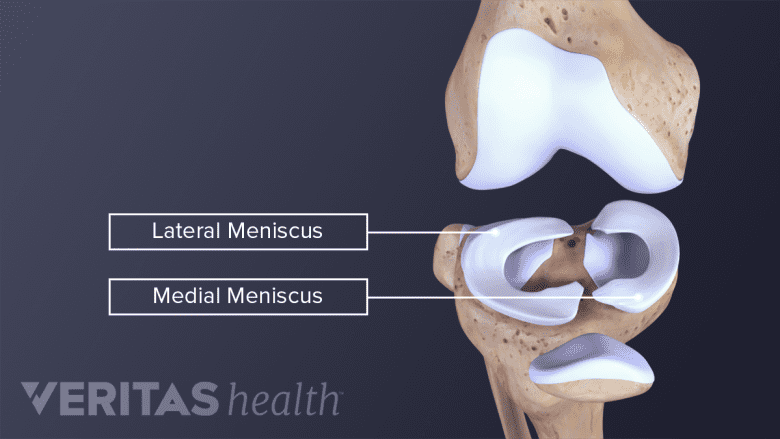The knee is the most commonly injured joint in runners. Most knee injuries are overuse injuries, which develop over time through repetitive movement.1 Left untreated, overuse injuries tend to gradually get worse.
The knees experience pressure equal to approximately 3 times the body's weight when walking and 5 times the body's weight when running.2 ,3 ,4 In other words, a person who weighs 150 lbs puts about 750 lbs of pressure on the knee when landing each running stride.
The first step to finding the right treatment for a knee injury is recognizing the underlying cause. This article reviews common knee injuries from running and jogging, including:
In This Article:
Runner’s Knee (Patellofemoral Pain Syndrome)5Patellofemoral pain syndrome (runner’s knee): Overview. In: InformedHealth.Org [Internet]. Institute for Quality and Efficiency in Health Care (IQWiG); 2020. Accessed September 11, 2023. https://www.ncbi.nlm.nih.gov/books/NBK561507/
Runner's knee is characterized by pain in the front of the knee, under or around the patella.
Pain at or near the kneecap may be runner’s knee, also called patellofemoral pain syndrome. In general, the root cause of this condition can vary and may be difficult to identify.
What it is: Patella means kneecap, and femur means thigh bone, so patellofemoral pain suggests a problem with how the kneecap and thigh bone fit and move together. The patella probably does not glide smoothly over the groove near the bottom of the femur.
In runners, patellofemoral pain syndrome is often linked to relatively weak hip muscles. This weakness may cause a runner to over-rely on their quadriceps muscles, which then tug uncomfortably on the kneecap.
How it feels: Runner’s knee causes pain at the front of the knee, under or around the edges of the kneecap. The pain is typically most noticeable going up or down stairs or walking or jogging on an incline. See Symptoms of Runner’s Knee
Read more about Runner’s Knee (Patellofemoral Pain Syndrome)
Iliotibial Band Syndrome6Bordalo-Rodrigues M, White LM. Knee. In: Hodler J, Kubik-Huch RA, von Schulthess GK, eds. Musculoskeletal Diseases 2021-2024: Diagnostic Imaging. IDKD Springer Series. Springer; 2021. Accessed September 11, 2023. http://www.ncbi.nlm.nih.gov/books/NBK570163/
IT band pain is felt just above the bony knob at the outside of the knee.
Pain at the outside of the knee, or lateral knee, could be a sign of iliotibial band syndrome.
What it is: The iliotibial band, or IT band, is a thick piece of fibrous tissue that runs along the outside of the thigh and ends just past the knee. Most doctors believe iliotibial band syndrome occurs when the IT band is too tight from overtraining or a strain.
Some experts have proposed two separate IT band conditions: iliotibial band friction syndrome and iliotibial band compression syndrome. Both conditions are linked to repetitive knee movement, but they differ in how they cause pain.
How it feels: Iliotibial band syndrome causes pain at or just above the bony knob at the outside of the knee. Pain is worse when running downhill and may feel sharp, especially as the condition gets more severe. See IT Band Syndrome Symptoms
No matter how IT band knee pain develops, treatment usually requires rest, stretching, and strengthening exercises. Surgery is typically not needed. See IT Band Syndrome Treatment
Read more about Iliotibial Band Syndrome
Jumper’s Knee (Patellar Tendonitis)
Jumper's knee results from inflammation of the patellar tendon.
Commonly called “jumper’s knee,” patellar tendonitis affects many runners, particularly those who run on downhill inclines. It can also affect people who participate in sports that require running with frequent starting and stopping, such as soccer, lacrosse or field hockey.
What it is: The patella tendon is a soft tissue that connects the patella (kneecap) to the upper tibia (shin bone). If this tendon becomes inflamed, it is called patellar tendonitis.
How it feels: Patellar tendonitis causes pain at the front of the knee, typically at the lower kneecap or the bony bump at the top of the shin. Initially, the pain may be mild and noticeable only at the start of a run. See Symptoms of Jumper’s Knee
Knee pain will become more constant as the condition gets worse. Some people also develop swelling, skin redness, and warmth at the knee joint.
Read more: Understanding Jumper’s Knee
Torn or Damaged Meniscus
Meniscal injuries cause pain in the exact location of the damaged meniscus.
People who are older, who run on uneven surfaces, or who make sudden turns and hard stops are at the greatest risk for a meniscus injury.
What it is: Menisci are c-shaped pads of cartilage that act as shock absorbers between the top of the shinbone and the bottom of the thigh bone. A meniscus can be torn in a trauma, such as a fall, or break down over time.
How a torn meniscus feels: The exact location of the knee pain will depend on where the meniscal injury occurs. The knee may be stiff and swollen. In addition, the knee may give way or lock if a piece of the torn meniscus prevents joint movement. See Symptoms of Meniscal Tears
While surgery is sometimes recommended to repair a torn meniscus, it is not always necessary. See Meniscal Tear Treatment
Read more: Understanding Meniscus Tears
ACL Sprain or Tear
Anterior cruciate ligament injuries cause sudden, sharp pain.
Unlike knee injuries that occur over time, an injury to the anterior cruciate ligament, or ACL, can usually be traced back to a specific fall, sudden pivot, or other trauma.
What it is: The ACL is one of several ligaments in the knee joint that connect the femur (thigh bone) to the tibia (shin bone). If put under too much strain, the ACL will become stretched and frayed, partially torn, or completely torn.
What it feels like: An ACL injury causes sudden, often sharp pain. After the initial pain dies down, symptoms will vary depending on how bad the injury is. See ACL Tear Symptoms
A mild ACL sprain might cause dull, throbbing pain that goes away at rest, while a complete tear may cause a lot of pain even at rest. The injured knee may swell, and it may be difficult or impossible to put weight on the affected leg.
Read more about Anterior Cruciate Ligament (ACL) Tears
Running with a sprained ACL or any other knee injury can worsen it. If knee pain does not go away after a couple of weeks of rest from running or jogging, or if the pain is severe, it is a good idea to seek medical care. A physician familiar with sports injuries, such as an orthopedist, physiatrist, or primary care physician, can make a diagnosis and recommend treatment.
- 1
- 2
- 3
- 4
- 5 Patellofemoral pain syndrome (runner’s knee): Overview. In: InformedHealth.Org [Internet]. Institute for Quality and Efficiency in Health Care (IQWiG); 2020. Accessed September 11, 2023. https://www.ncbi.nlm.nih.gov/books/NBK561507/
- 6 Bordalo-Rodrigues M, White LM. Knee. In: Hodler J, Kubik-Huch RA, von Schulthess GK, eds. Musculoskeletal Diseases 2021-2024: Diagnostic Imaging. IDKD Springer Series. Springer; 2021. Accessed September 11, 2023. http://www.ncbi.nlm.nih.gov/books/NBK570163/










